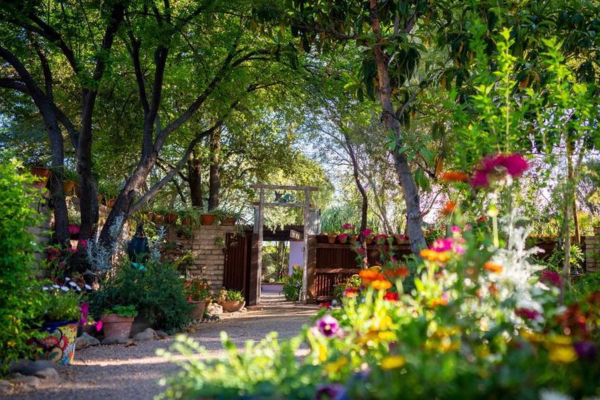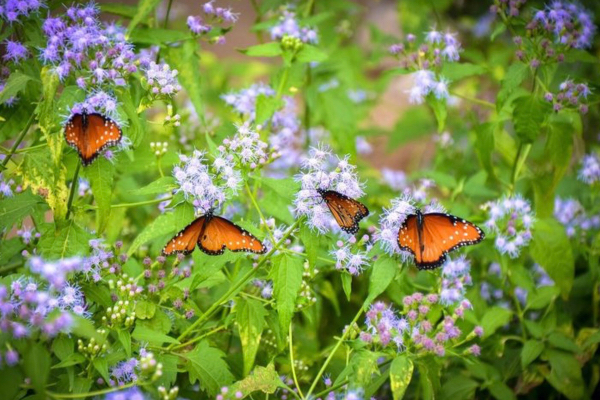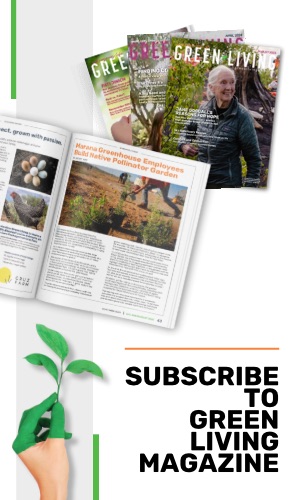By Adam Farrell-Wortman, Director of Horticulture
The Tucson Botanical Gardens is an oasis in both the narrowest and broadest of definitions. The 5.5 acres of 20 garden rooms in Midtown play host to an eclectic collection of plant species from around the world. It is also teaming with life attracted by the food, water and refuge from the harsh conditions of the urban desert. Native and migratory birds and butterflies, native reptiles and amphibians, native and urban mammals – all depend on the Gardens. How the horticulture team cares for the plant collection affects this ecosystem – from the soil microbes to the human visitors. Like all gardens, The Tucson Botanical Gardens must deal with pest pressures – the complex factors that lead to pest activity and damage to plants and gardens – which, in our case, could cause catastrophic damage to valuable specimens. We apply a system of Integrate Pest Management (IPM), a holistic approach that focuses on maintaining the ecological balance of the ecosystem.
Prioritizing Soil Health

At the Gardens, we prioritize soil health to create optimal conditions for strong and healthy plant growth. Healthy soil can collect and evenly distribute moisture through a garden bed, essential in our arid environment. It contains all the nutrients a plant needs, and in a form the plant can readily access. In addition to decomposing organic matter, microbes in the soil can even replace some of the nutrients the plant takes up, for example nitrogen, fixed from the atmosphere. The plant regulates the uptake of nutrients, so that it doesn’t grow too fast for its own good. A healthy, well-regulated plant is less likely to be attacked by pests. If attacked, it has stronger immune defenses and is better able to recover.
Balancing Act

An acknowledgment that the organisms we consider to be pests are part of the greater ecological balance is key to IPM. Total elimination is rarely if ever the goal. Pest insects, for example, are a food source for other insects, birds and lizards: prey for the predator. If we eliminate, say, every aphid, then the insects that eat the aphids will also be eliminated. We avoid using toxic treatments for the same reason. If we poison a plant eating insect, we may also be poisoning the insect-eating lizard or bird. Once again, we are striving for balance, making sure that the system isn’t off kilter to avoid a plant from being overwhelmed or threatened.
Prevention vs Cure
In its application of IPM, the horticulture team uses a combination of cultural, physical, and non-petrochemical tools to minimize economic, health, and environmental risks to the collection.
- Cultural tools: observing, planning, pruning, cleaning.
- Physical tools: barriers, traps, and habitat creation/destruction, biological (introduction of predatory/beneficial organisms.
- Non-petrochemical tools: e.g. botanical oils like neem or citrus oil for direct pest control; nematodes as a direct biologic pest control; and soil amendments such as compost, biochar, humic acid, and various meals.
IPM also places emphasis on design and gardening techniques such as planting at the right time of year, planting in the proper sun exposure, and incorporating predator habitat into the garden design. These simple steps can stop pest issues before they start – an ounce of prevention is worth is a pound of cure! Next time you’re visiting the Tucson Botanical Gardens and enjoying the incredible collection of 7,000 plant species remember, you are not alone! There is an abundance of winged and legged critters all around you, honorary members, you might say, of the IPM crew.






Good article but it only touches the surface. It would be great to see links on the non-petrochemical options to learn more. And how to deter pests. We have pack rats that are very destructive to property, and finding non poisonous solutions to make them find our property “unfriendly”.